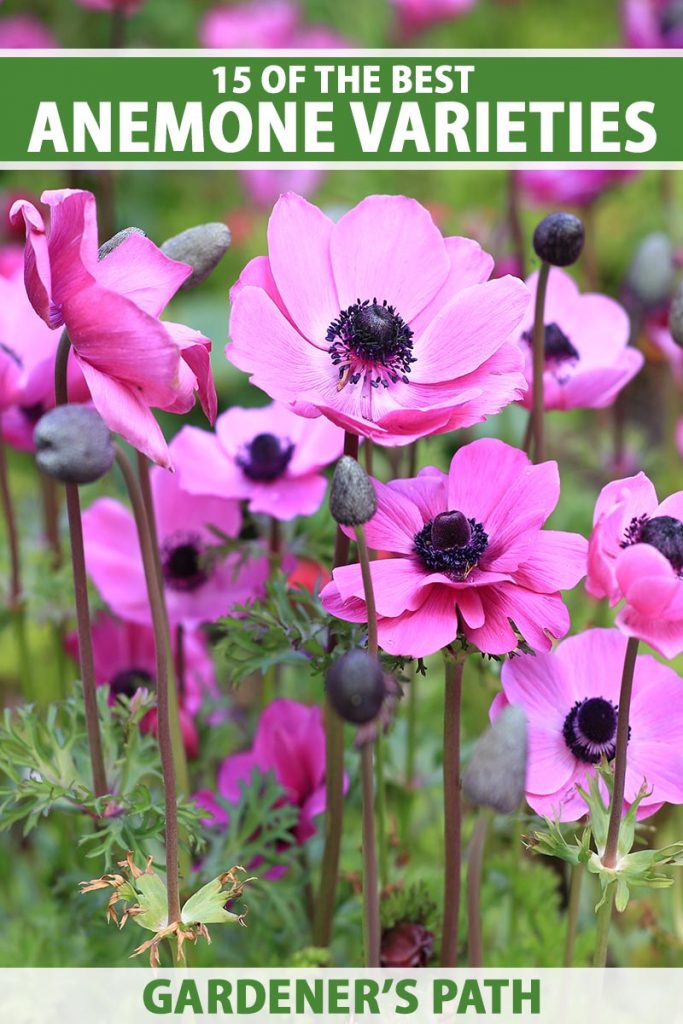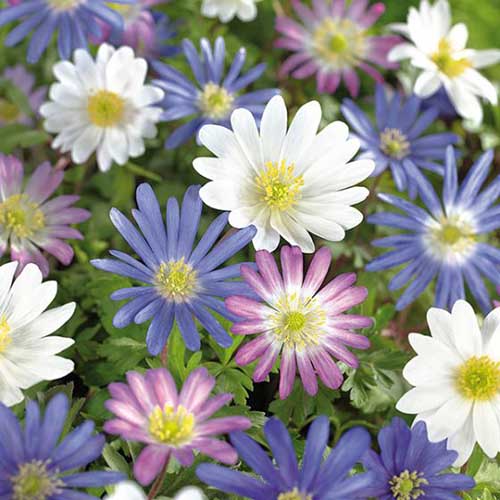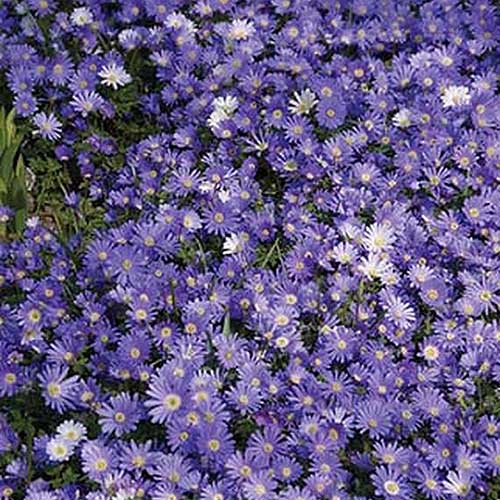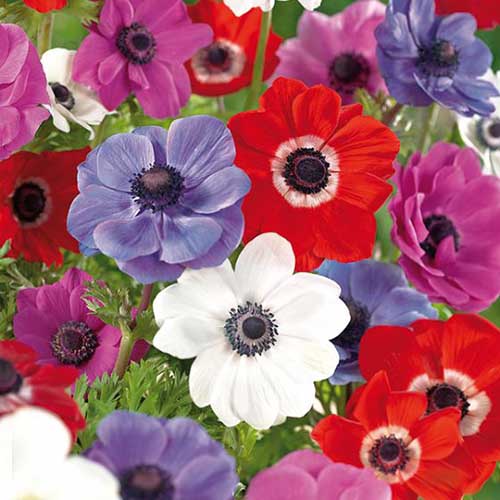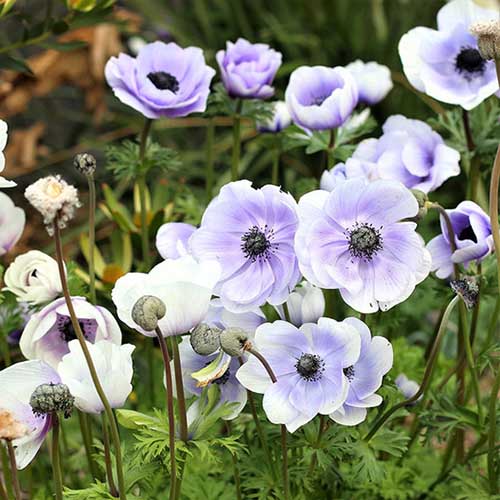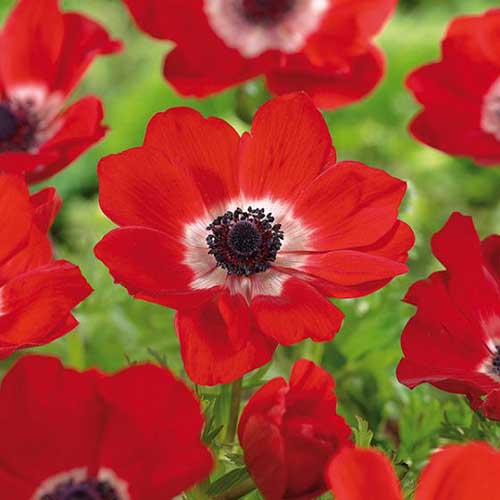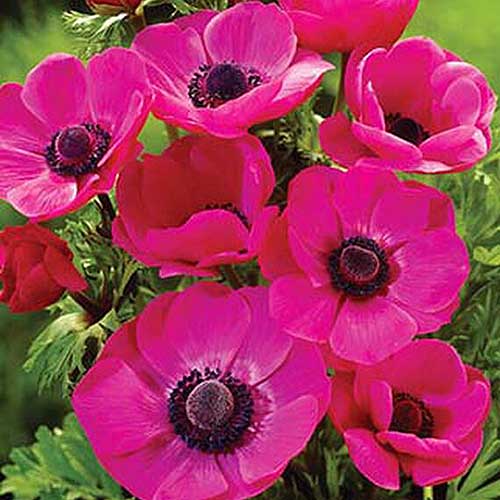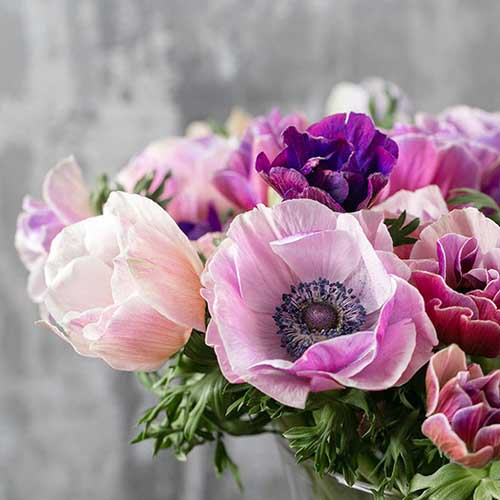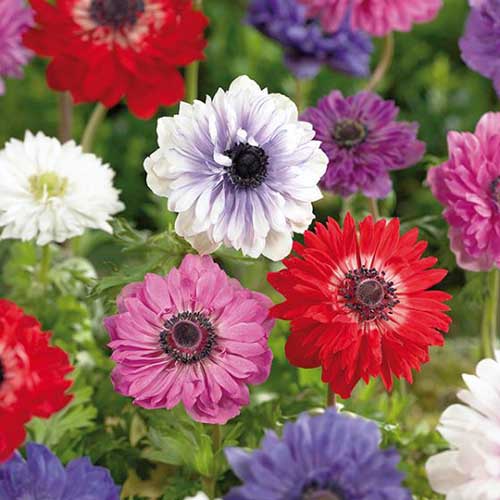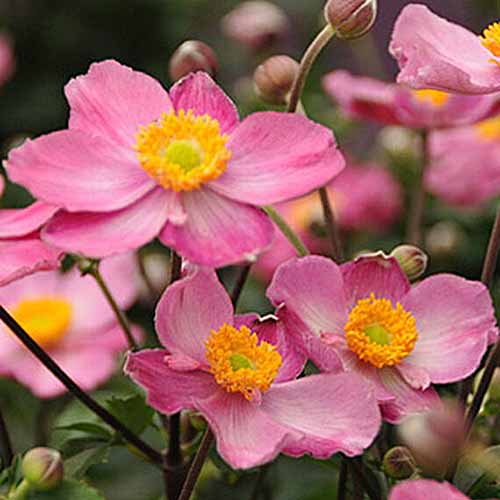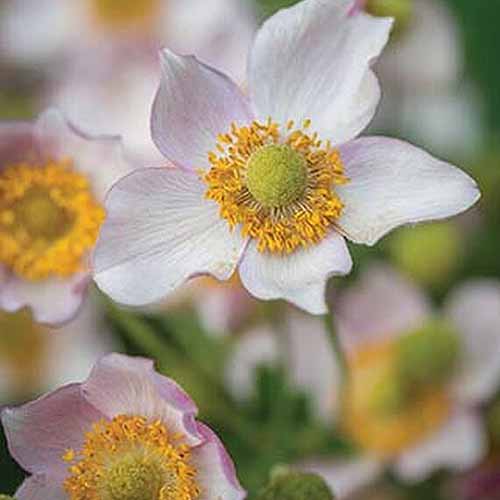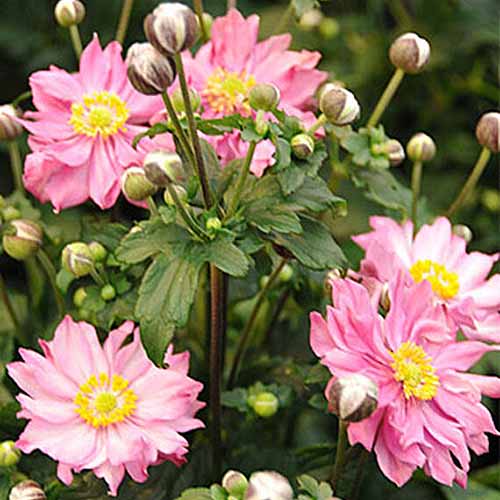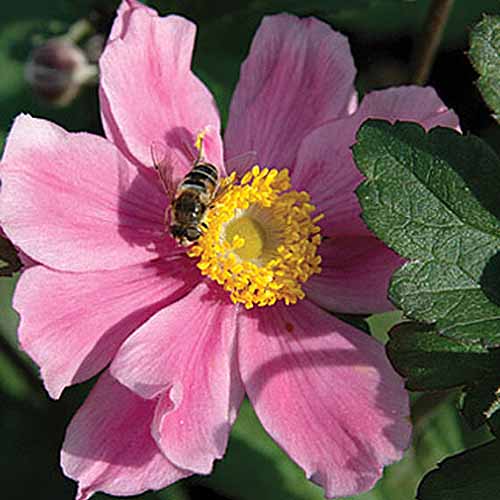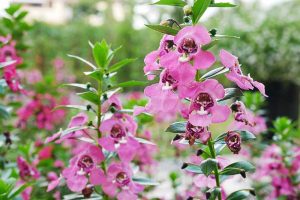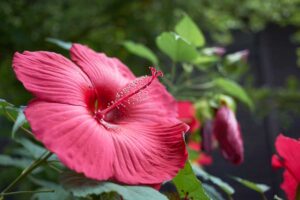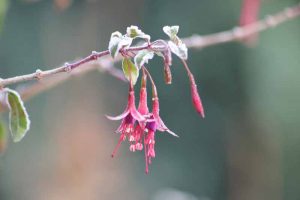Charming and diverse, anemones put on an eye-catching and long-lasting floral display from early spring into fall.
Anemone is a large genus, and many folks will be familiar with the charm of the daisy-like Grecian windflowers, aka Balkan anemones, that pop up in early spring.
They’re soon followed by other species with delightful poppy-like flowers, some that bloom from late spring into summer and others flowering from late summer into fall.
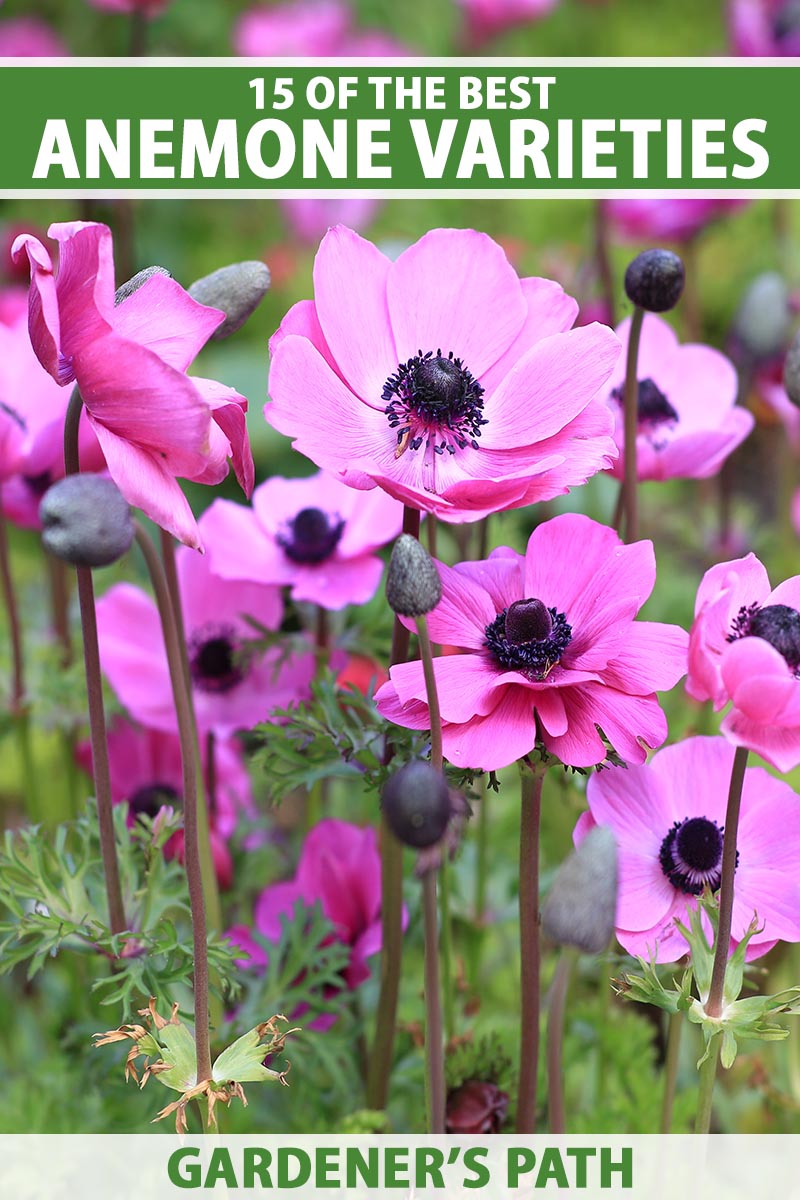
We link to vendors to help you find relevant products. If you buy from one of our links, we may earn a commission.
A knockout when mass planted in containers and throughout the garden, they also naturalize readily – given the right conditions.
And with long-lasting blooms, colorfast petals, and tall, sturdy stems, many cultivars make spectacular cut flowers as well.
Anemones are easily cultivated as perennials but they also make reliable annuals, typically blooming just three months after planting.
If colorful, low maintenance plants appeal to you, read on to learn about 15 of the best anemone varieties for spring, summer, and fall.
15 Favorite Anemone Varieties for Your Garden
An Introduction to Anemones
Members of the Ranunculaceae (buttercup) family, there are several species of Anemone favored for home cultivation.
Plants come in a variety of sizes, depending on the species or cultivar: from low-growing types of six to eight inches in height, to tall, four-footers that make splendid, long-lasting cut flowers.
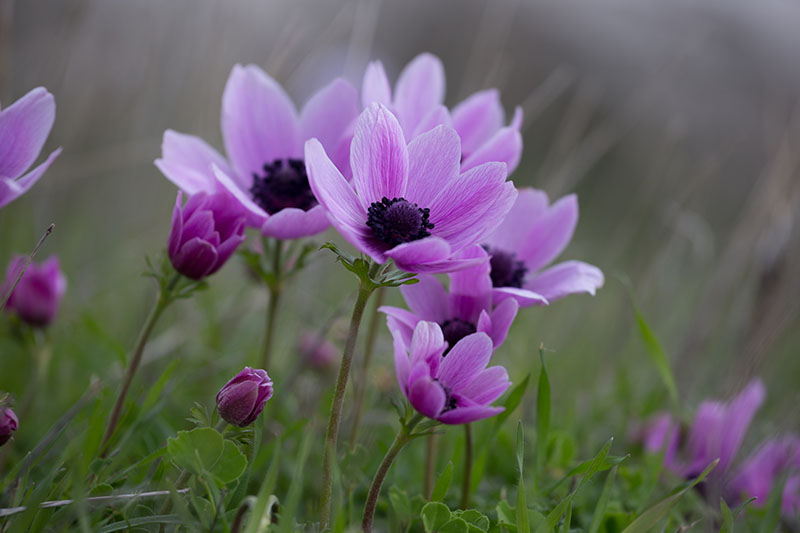
Whatever the plant size, they provide a pretty display in bright shades of blue, mauve, pink, purple, red, and white.
Many have dazzling button eyes in their centers, often with a sassy fringe! Some are dark and dramatic, a deep indigo blue or black, while others are light and bright, with chartreuse to golden anthers.
Those that flower in early spring have narrow, daisy-like petals, while summer and fall bloomers have wide petals and look more like poppies.
Carefree and easy to grow in moist, well-draining soil, anemones enjoy full to part sun locations – either with morning sun and afternoon shade or dappled light throughout the day.
They’re also deer and rabbit resistant as well as salt tolerant, making them a good choice for critter-friendly locations and coastal gardens.
Butterflies and other pollinators are attracted to the flowers, and many of the summer and fall-flowering species have pretty, cottony seed heads – a nesting material favored by hummingbirds and small songbirds.
A Note of Caution: all parts of anemone plants are toxic when ingested and should be kept away from children and pets.
Anemones also enjoy a variety of growth patterns:
Tuberous Species
Tuberous species typically bloom in spring and early summer, and include A. blanda aka Balkan or Grecian windflowers, and A. coronaria.
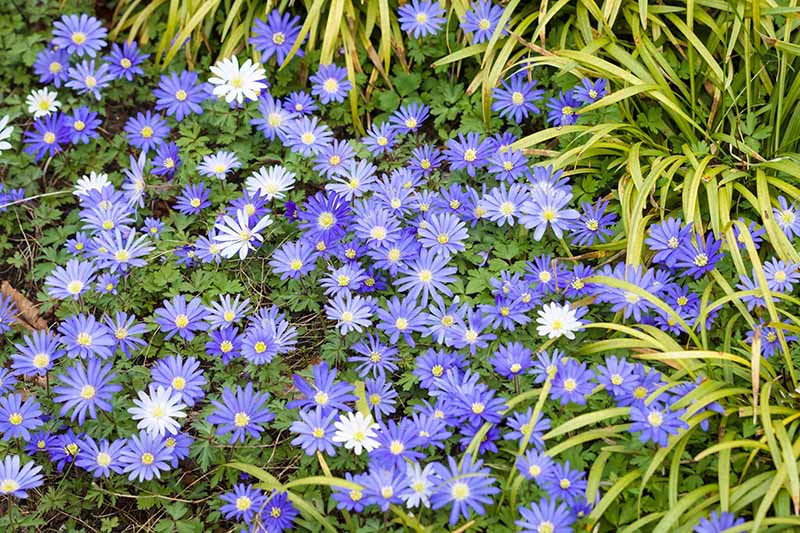
A. coronaria cultivars are commonly divided into two main groups: ‘De Caen’ and ‘St. Brigid.’ The ‘De Caen’ cultivars are single-petalled, while the ‘St. Brigid’ types are doubles.
Native to Eurasia, these are low to mid-sized species that grow from hard, gnarly corms or rhizomes.
The early A. blanda varieties can be grown in full or part sun and like a humus-rich, well-draining soil with consistent moisture.
For more details about A. blanda, you can read all about how to grow Grecian windflowers here.
The poppy-like A. coronaria cultivars, blooming in late spring and early summer, enjoy more heat and prefer a full sun location.
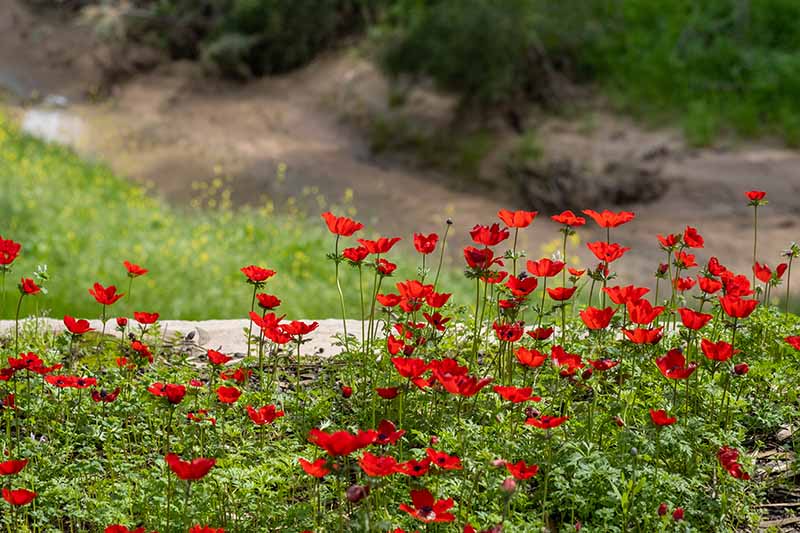
A. blanda typically thrives in USDA Hardiness Zones 5-9, but A. coronaria is hardy only in Zones 7-10.
Although they provide a longer bloom time when planted in fall, they can be successfully grown as annuals in cooler locations when put in the ground in early spring.
Fibrous Rooted Species
Fibrous-rooted species are typically the alpine or woodland varieties, with several species that are native to North America.
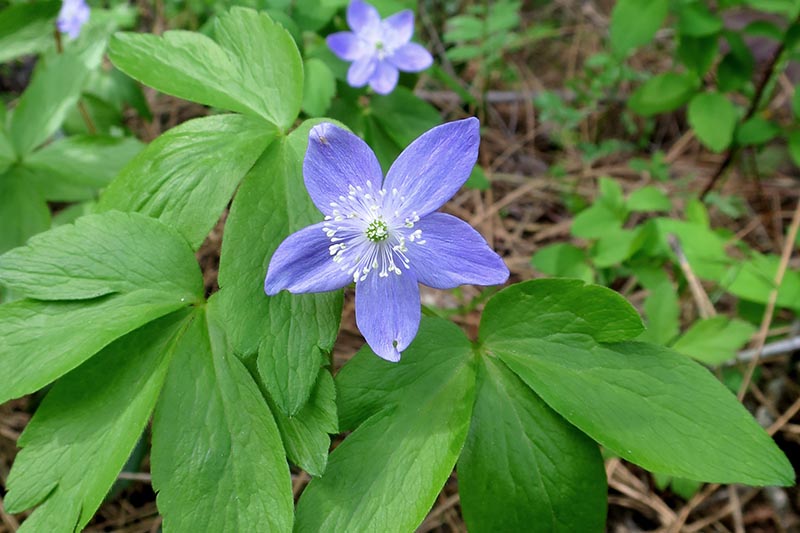
These are low growing or mid-sized plants that flower in spring and early summer, and grow from fibrous roots or clumps of thin, rhizomatous roots.
Many of these species, like A. canadensis and A. oregana, are hardy in Zones 3 and 4, and one Arctic species, A. parviflora, is hardy down to a frigid Zone 1!

These species can be hard to find in garden centers. But many can be sourced from local botanical gardens and horticultural schools, or from rare and native species websites.
Fall Flowering Species and Hybrids
Chinese or Japanese anemones, A. hupehensis, A. tomentosa, and A. vitifolia are fall flowering species that bloom in late summer and early autumn, with saucer-shaped flowers in shades of pink, rose, and white.
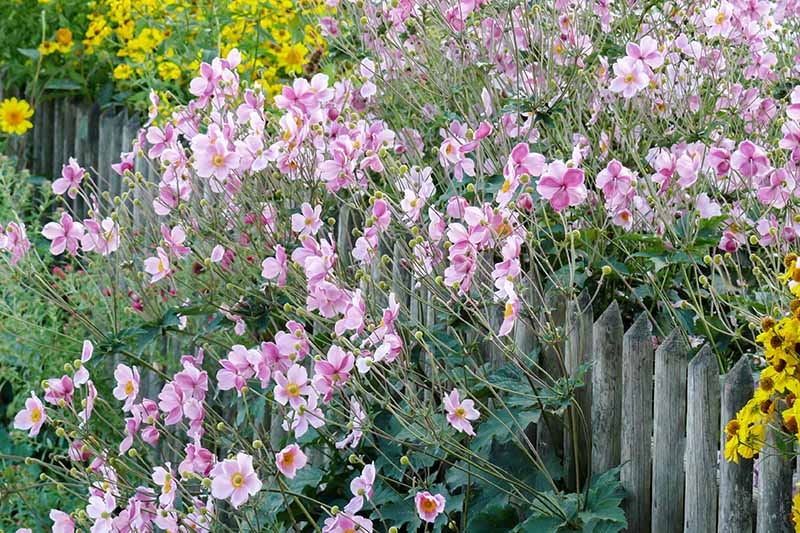
Cultivated hybrid varieties are typically bred from one A. hupehensis parent and are collectively called A. x hybrida.
These are tall species that can grow up to four feet and make wonderful cut flowers, with many cultivars hardy in Zones 3-5.
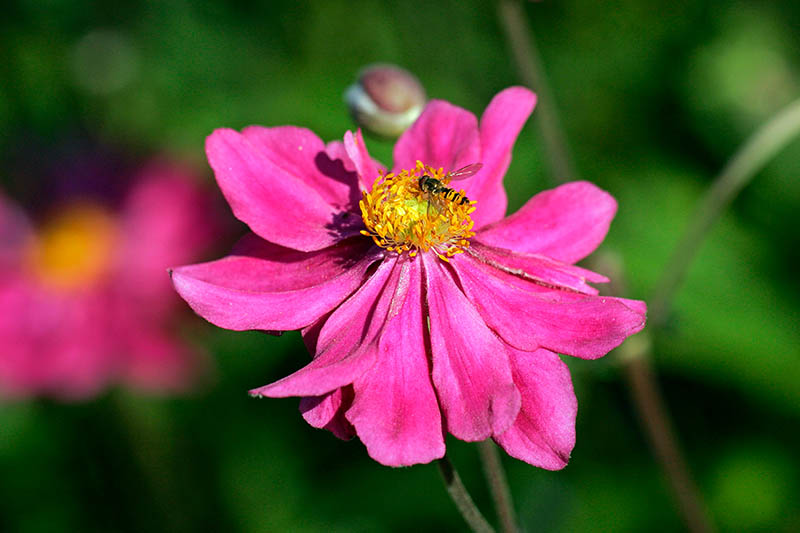
They prefer a lightly shaded location, or morning sun with afternoon shade, and require organically rich, well-draining soil that’s kept evenly moist.
For more know-how about fall flowering species, read our guide on how to grow Japanese anemones.
Spring and Summer Blooming Cultivars to Select
Tuberous varieties are popular for spring and early summer.
1. Blanda Mix
Blanda Mix is a mixture of A. blanda bulbs that deliver a showy display of daisy-like flowers in shades of periwinkle blue, dusty pink, and white, with a fresh, green-gold center.
Low growing, with a mature height of only three to five inches, the mixed colors provide an attractive display when mass planted under deciduous trees and in naturalized settings, or grouped in beds, borders, containers, and rockeries.
Plant in full to part sun in humus-rich, sandy soil that’s evenly moist and well-draining. Hardy in Zones 4-8.
Packets of 12 bulbs can be purchased at Nature Hills Nursery.
2. Blue Shades
An early spring classic, A. blanda ‘Blue Shades’ flowers in blue tones ranging from powder to periwinkle, with charming, bright white eyes and ferny foliage.
The low growing plants reach only four to six inches high at maturity and look terrific when mass planted singly or with other early bloomers like daffodils, grape hyacinth, and crocus.
Plant the corms in fall and locate at the front of beds and borders, in containers, or scattered in woodlands and under deciduous trees.
This cultivar grows in full or part sun and makes an adorable ground cover for shady areas of the garden. Hardy in Zones 4-8.
You can find packets of 15 bulbs available at Burpee.
3. De Caen Mix
A. coronaria ‘De Caen’ mix produces large, buttercup flowers in fantastic shades of scarlet, rosy pink, violet, and white that bloom from mid to late spring.
Hardy in Zones 7 to 10, plants grow to mature heights of eight to 10 inches and spread rapidly when grown in a full to part sun location in loamy, evenly moist soil.
They make a charming ground cover for lightly shaded areas and look spectacular in beds, borders, and containers, or planted in alpine, cottage, and rock gardens.
You can find packets of 12 bulbs available at Nature Hills Nursery.
4. De Caen Blue White
A. coronaria ‘De Caen Blue White’ delivers lovely bicolored blooms, emerging from the dark center as a deep, azure blue that fades to white at the petal edges.
The low-growing plants reach mature heights of 10 to 12 inches and have a long bloom time of eight to 10 weeks, flowering from late spring into early summer.
Beautiful for the cutting garden and natural areas, or when planted en masse in beds, borders, containers, and alpine or rock gardens.
‘De Caen Blue White’ is hardy in Zones 6-10, and prefers a full sun location in a loamy, well-draining soil.
Bags of 20, 40, or 60 bulbs are available at Eden Brothers.
5. Hollandia
For a striking statement, A. coronaria ‘Hollandia’ delivers a vibrant display of scarlet flowers with black and white centers that bloom all spring.
Delightful as cut flowers, cut stems are quickly replaced with new flowers. Fantastic when mass planted in beds, borders, containers, and rockeries or when allowed to spread as a ground cover in naturalized settings like meadows and woodland fringes.
‘Hollandia’ grows eight to 10 inches tall and requires loamy, well-draining soil in a full to part sun location. Hardy in Zones 7-10.
You can find packets of 12 bulbs available at Nature Hills Nursery.
6. Mona Lisa
Highly prolific, A. coronaria ‘Mona Lisa’ features poppy-like flowers in hot pink with dazzling, dark eyes that sit atop long stems.
The spring blooms are ideal as long-lasting cut flowers, and they make a striking statement in beds, borders, containers, and alpine or rock gardens.
Plants grow to 18 inches tall and prefer a part sun location with afternoon shade. Hardy in Zones 5-8.
You can find sets of four plants available at Burpee.
7. Mr. Fokker
A. coronaria ‘Mr. Fokker’ features spectacular velvety purple-blue flowers with charming black button eyes that bloom from mid to late spring.
Hardy in Zones 7-10, these clump-forming plants grow eight to 10 inches tall and do best in a full sun location and sandy, well-draining soil.
They make delightful cut flowers and add their reliable appeal to beds, borders, containers, or in alpine, cottage, or rock gardens.
You can find packets of 12 bulbs available at Nature Hills Nursery.
8. Rainbow Pastel Mix
A. coronaria Rainbow Pastel Mix is a sweet mix of pastel, bicolored poppy-like blooms in shades of lavender, rosy pink, and violet, with almost-white flowers tinged in mauve and pink.
All colors have striking dark eyes of deep indigo or black.
Prolific bloomers, these 10- to 12-inch-tall plants often produce up to 20 flowers per bulb, blooming in late spring to early summer.
They are ideal for the cutting garden, or as a naturalized ground cover in meadows and lawn fringes. Use for large specimen grouping or scattered throughout beds, borders, and in containers.
Hardy in Zones 6-10, plant in a full to part sun location with organically rich, well draining soil.
Find bags of 20, 40, or 60 bulbs available at Eden Brothers.
9. St. Brigid Mix
The brightly hued and lightly ruffled double blooms of A. coronaria ‘St. Brigid’ mix float above fern-like foliage, adding delightful color to the late spring garden.
Brilliant, long-lasting shades of blue, mauve, pink, scarlet, and white have contrasting dark or self-colored centers, and make excellent cut flowers in a spring bouquet.
A natural in alpine or rock gardens, they shine in beds, borders, containers, or naturalized in meadows.
Plants prefer a full to part sun location with moist and loamy, well-draining soil. Hardy in Zones 7-10.
Packets of 12 bulbs are available at Nature Hills Nursery.
Fall Flowering Cultivars to Select
There are many outstanding fall cultivars, with flowers appearing in August and flowering through October.
10. Cinderella
Outstanding from mid-summer to October, A. x hybrida ‘Cinderella,’ part of the Fantasy™ series, has tall, branching stems with princess-pink flowers and frilly yellow stamen.
After flowering, fluffy white seed heads add fall interest to the garden.
Plants grow 12 to 18 inches tall, making them a superb addition to the cutting garden. They are also well suited to shade gardens or in beds, borders, containers, and naturalized in woodland settings.
Hardy in Zones 5-8, plants prefer rich, moist soil in part sun sites.
You can find packets of 15 bulbs available at Burpee.
11. Honorine Jobert
Stately and elegant, A. hupehensis ‘Honorine Jobert’ shines in the late summer garden, with brilliant white flowers tinged in pink, and eye-catching golden stamen.
The three to four-feet-tall plants look marvelous when mass-planted in beds, containers, cottage and cutting gardens, and woodland settings.
Plants love a full to part sun location and thrive in humus-rich, moist soil. Hardy in Zones 4-8.
You can find packets of 15 bulbs available at Burpee.
12. Leather and Lace
With tall, branching stems, A. x hybrida ‘Leather and Lace’ produces a profusion of pretty blooms from late summer into fall.
The waxy, almost-white petals have a hint of pink and a green and gold eye in the center.
Thick, suckering stems grow two to three feet tall and make beautiful cut flowers. Or they can be massed in beds, borders, containers, cottage gardens, and naturalized areas.
Hardy in Zones 5-8, they thrive in part sun, making them a natural in the shade garden planted with astilbe and hostas.
You can find plants available to purchase at Burpee.
13. Pocahontas
Another cultivar in the A. hupehensis Fantasy™ series, the double-petaled ‘Pocahontas’ puts on a glorious, ruffled display in bubblegum pink with bright, sunshine-yellow eyes.
They bloom for months, from midsummer to almost the middle of autumn.
The sturdy stems grow to a mature height of 12 to 18 inches and plants colonize readily, making them ideal for cottage and cutting gardens. Or massed in beds, borders, containers, and naturalized settings like meadows or woodlands.
Fluffy white seed heads add fall and winter interest and provide nesting material for small songbirds the following spring.
Plants prefer full to part sun in organically rich, well-draining soil. Hardy in Zones 5-8.
You can find plants available at Burpee.
14. September Charm
Vigorous and prolific, A. x hybrida ‘September Charm’ produces multitudes of luminous, silvery-pink flowers with a deeper, purply-pink reverse and a frothy, golden center.
The display lasts from mid-summer to mid-autumn and plants grow to a height of 24 to 48 inches. Gorgeous for cottage and cutting gardens or mass planted at the rear of beds, in borders or large containers, and in woodland settings.
‘September Charm’ grows best in evenly moist, well-draining soil in part sun, and is hardy in Zones 4-8.
You can find bare root plants available at Burpee.
15. Wild Swan
Outstanding in the late summer and fall garden, A. x hybrida ‘Wild Swan’ puts on a radiant display of large, white petals with violet-blue reverse sides and golden centers.
Wonderfully prolific, it also has one of the longest bloom times, flowering from early summer to mid-autumn. Growing to a mature height of 16 to 18 inches, they make stunning cut flowers.
Well-suited as accents in beds, borders, and containers or mass planted, ‘Wild Swan’ is hardy in Zones 6-8.
You can find plants available for purchase at Burpee.
Wonderful Windflowers
With beautiful, bright flowers that sway in the wind, anemones make a great addition to the spring, summer, or fall garden.
Wonderfully low maintenance, they grow in full sun or light shade. And with such a wide selection of species and cultivars, there’s bound to be one (or more!) suitable for almost any location. Plus, they make fantastic cut flowers!
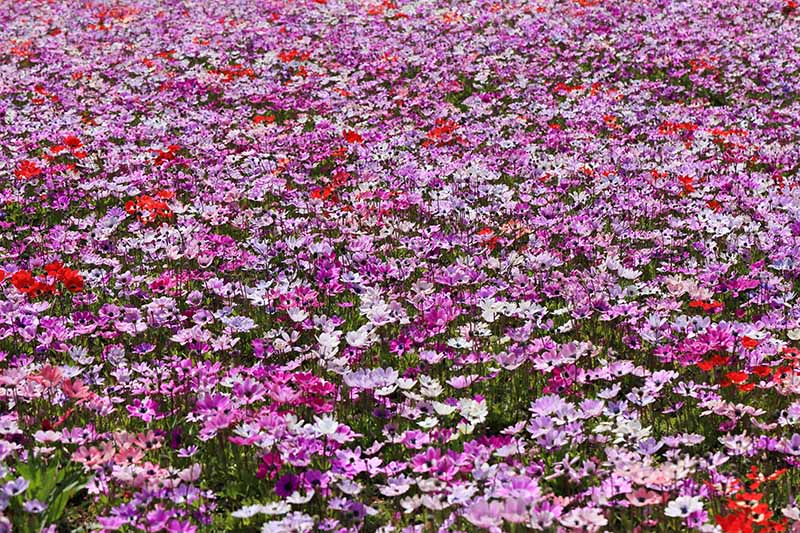
I’ve decided the ‘De Caen’ mix needs a home in my garden… and more Grecian windflowers!
How about you, which varieties will you grow? Let us know in the comments section below!
And be sure to check out some of these other low-maintenance stalwarts for reliable garden color next:
- How to Grow and Care for Candle Anemones
- 25 of the Best Agapanthus Varieties for Your Garden
- 15 of the Best Daffodil Cultivars for Naturalized Plantings
- 19 Dazzling Delphiniums for Your Flower Beds
© Ask the Experts, LLC. ALL RIGHTS RESERVED. See our TOS for more details. Product photos via Burpee, Eden Brothers, and Nature Hills Nursery. Uncredited photos: Shutterstock.
